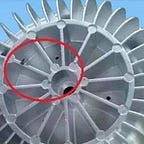Selection of stamping materials
Selection of stamping materials:
The three most important steps in a stamping factory are shearing, punching/cutting, and folding.
Stamping parts are sometimes used as metal plate. The word comes from the English platemetal. Generally, some metal sheets are plastically deformed by hand or die stamping to form the desired shape and size, and can be further processed by welding or a small amount of machining. Forming more complex parts, such as chimneys commonly used in households, iron stoves, and car shells are all sheet metal parts. Stamping processing is called sheet metal processing. Specifically, for example, the use of plates to make chimneys, iron barrels, fuel tanks, oil tanks, ventilation pipes, elbows, landscaping, funnels, etc. The main processes are shearing, bending, bending, forming, welding, riveting, etc. Certain geometric knowledge. Stamping parts are thin-plate hardware parts, that is, parts that can be processed by Copper stamping, bending, stretching and other means. A general definition is-a part with a constant thickness during processing. Corresponding to castings, forgings, machining parts, etc., for example, the outer iron shell of a car is sheet metal, and some kitchen utensils made of stainless steel are also sheet metal.
Material selection
The materials generally used in sheet metal processing are cold rolled plate (SPCC), hot rolled plate (SHCC), galvanized plate (SECC, SGCC), copper (CU) brass, red copper, beryllium copper, aluminum plate (6061, 5052) 1010, 1060, 6063, duralumin, etc.), aluminum profiles, stainless steel (mirror surface, brushed surface, matte surface), depending on the role of the product, the choice of materials is different, and generally need to be considered from the product’s use and cost.
1. Cold-rolled sheet SPCC is mainly used for electroplating and baking varnish parts, low cost, easy to shape, and material thickness ≤ 3.2mm.
2. Hot-rolled sheet SHCC, material T≥3.0mm, also uses electroplating, baking varnish parts, low cost, but difficult to form, mainly flat parts.
3. Galvanized sheet SECC, SGCC. SECC electrolytic board is divided into N material and P material. N material is mainly used for surface treatment and high cost. P material is used for sprayed parts.
4. Copper; mainly uses conductive materials, and its surface treatment is nickel plating, chrome plating, or no treatment, which is costly.
5. Aluminum plate; generally use surface chromate (J11-A), oxidation (conductive oxidation, chemical oxidation), high cost, silver plating, nickel plating.
6. Aluminum profiles; materials with complex cross-section structures are widely used in various sub-boxes. The surface treatment is the same as the aluminum plate.
7. Stainless steel; mainly used without any surface treatment, high cost.
Selection of materials
The materials generally used in sheet metal processing are cold rolled plate (SPCC), hot rolled plate (SHCC), galvanized plate (SECC, SGCC), copper (CU) brass, red copper, beryllium copper, aluminum plate (6061, 5052) 1010, 1060, 6063, duralumin, etc.), aluminum profiles, stainless steel (mirror surface, brushed surface, matte surface), depending on the role of the product, the choice of materials is different, and generally need to be considered from the product’s use and cost.
1. Cold-rolled sheet SPCC is mainly used for electroplating and baking varnish parts, low cost, easy to shape, and material thickness ≤ 3.2mm.
2. Hot-rolled sheet SHCC, material T≥3.0mm, is also used for electroplating and baking varnish parts, low cost, but difficult to form, mainly flat parts.
3. Galvanized sheet SECC, SGCC. SECC electrolytic board is divided into N material and P material. N material is mainly used for surface treatment and high cost. P material is used for sprayed parts.
4. Copper; mainly uses conductive materials, and its surface treatment is nickel plating, chrome plating, or no treatment, which is costly.
5. Aluminum plate; generally use surface chromate (J11-A), oxidation (conductive oxidation, chemical oxidation), high cost, silver plating, nickel plating.
6. Aluminum profiles; materials with complex cross-section structures are widely used in various sub-boxes. The surface treatment is the same as the aluminum plate.
7. Stainless steel; mainly used without any surface treatment, high cost.
